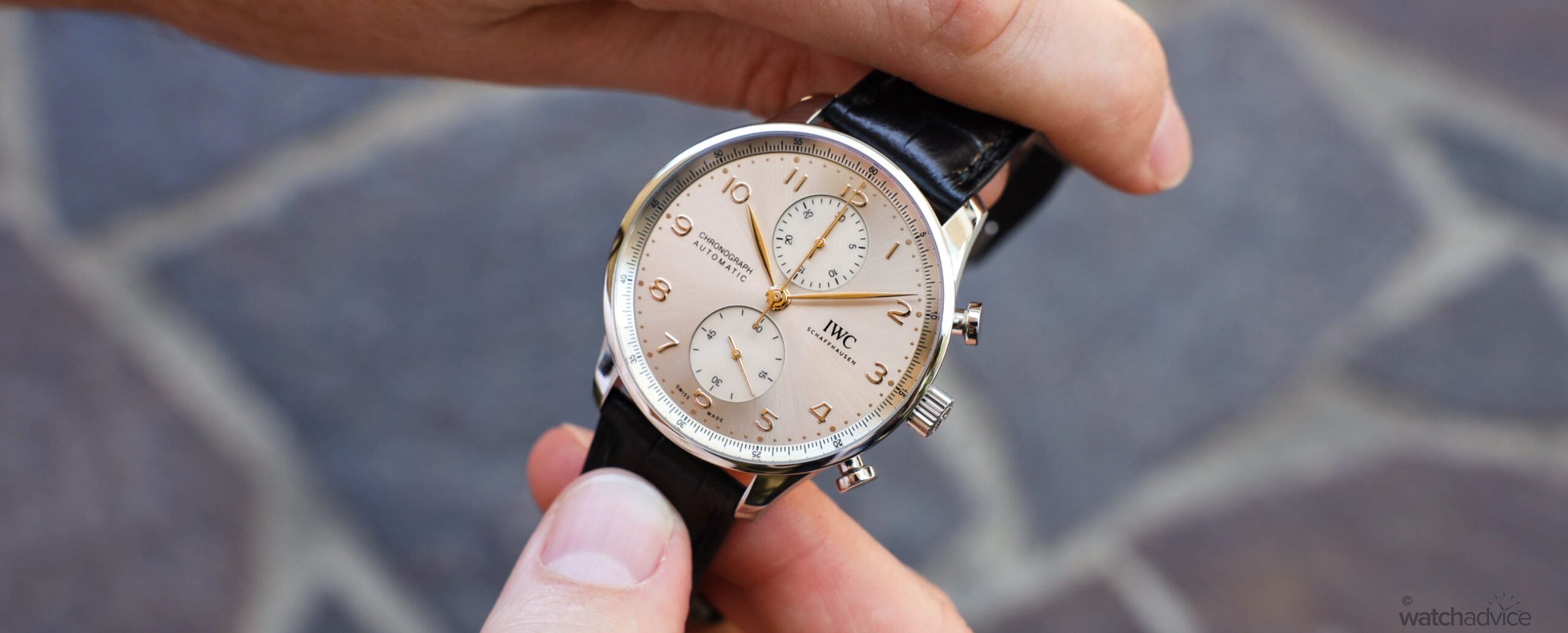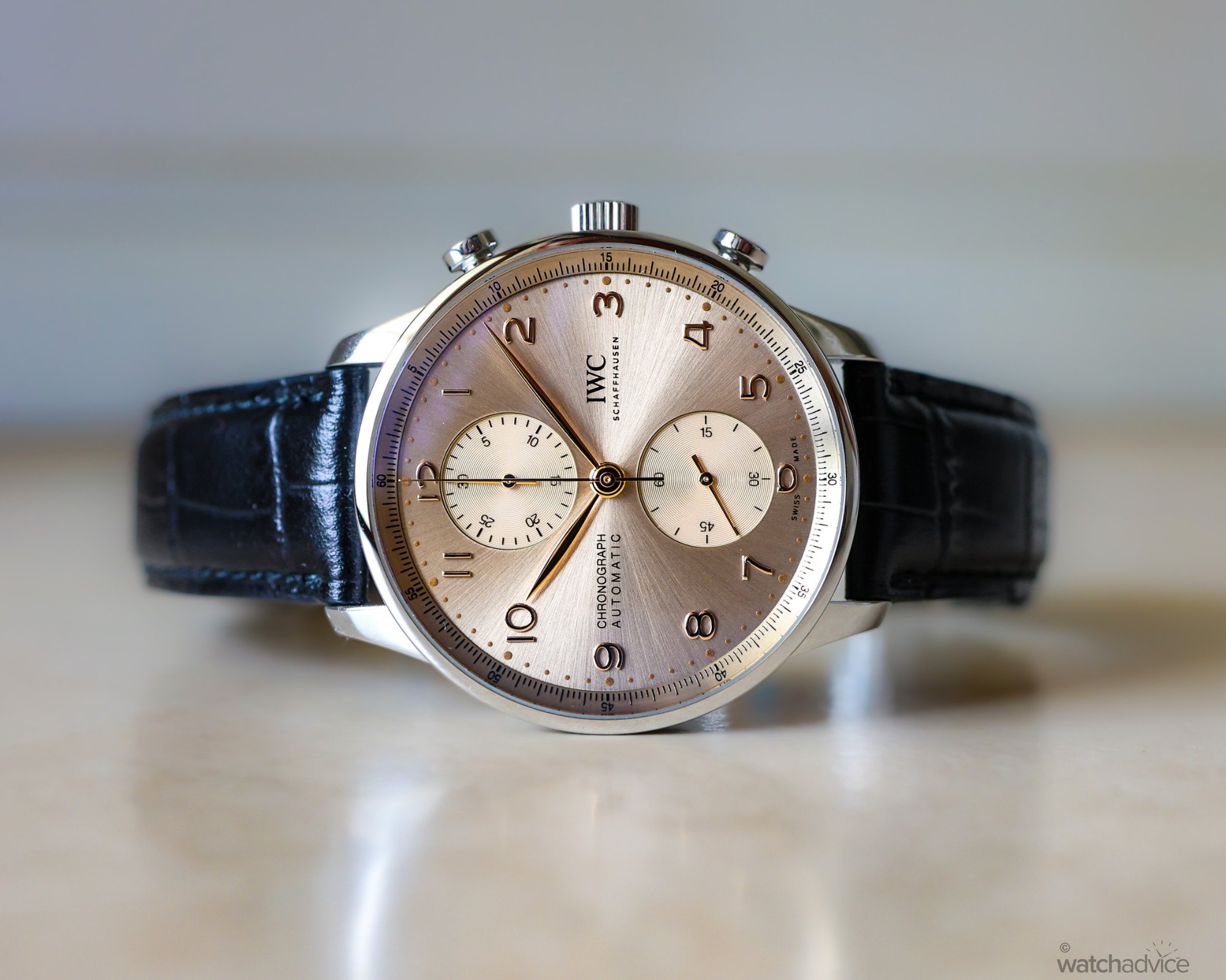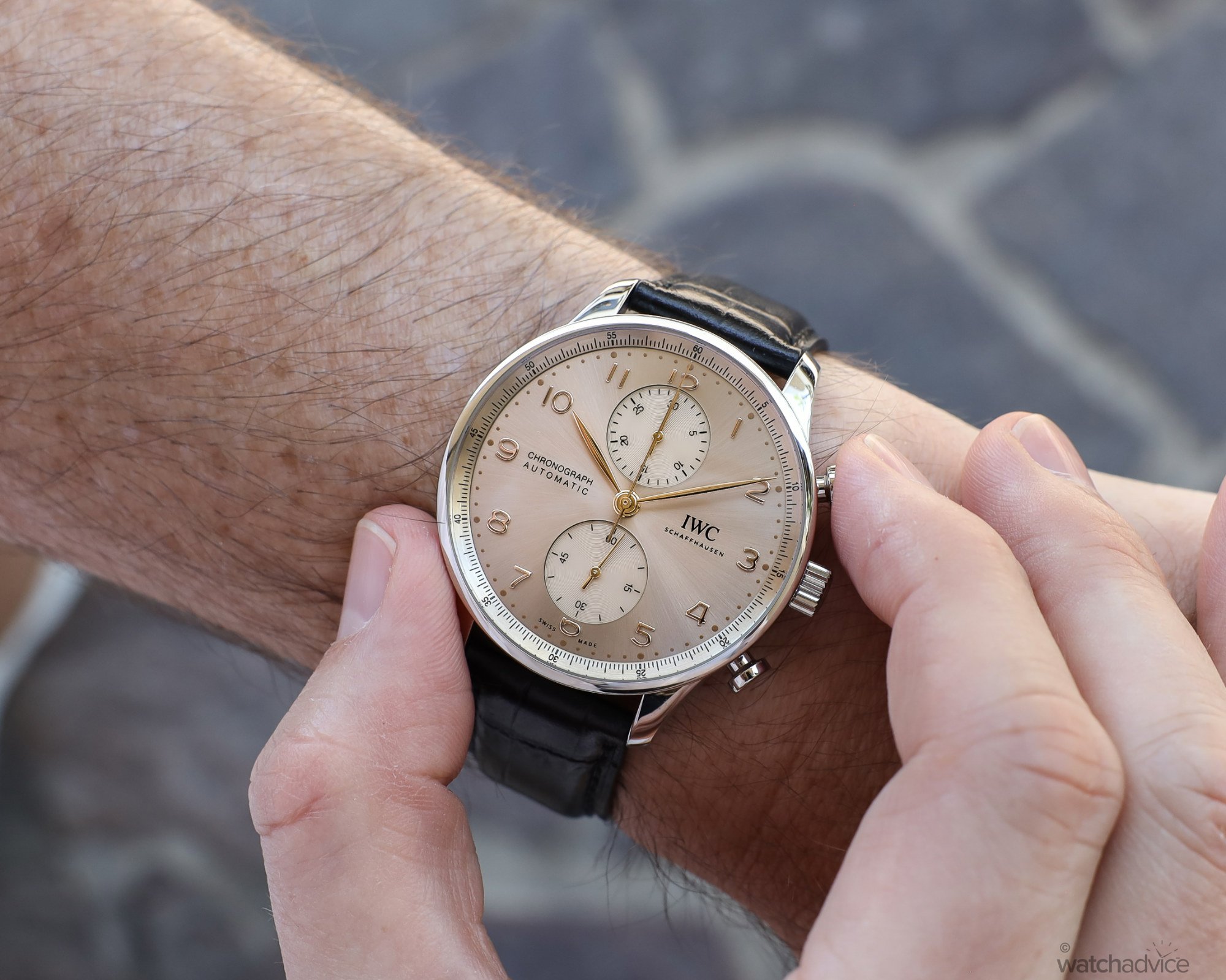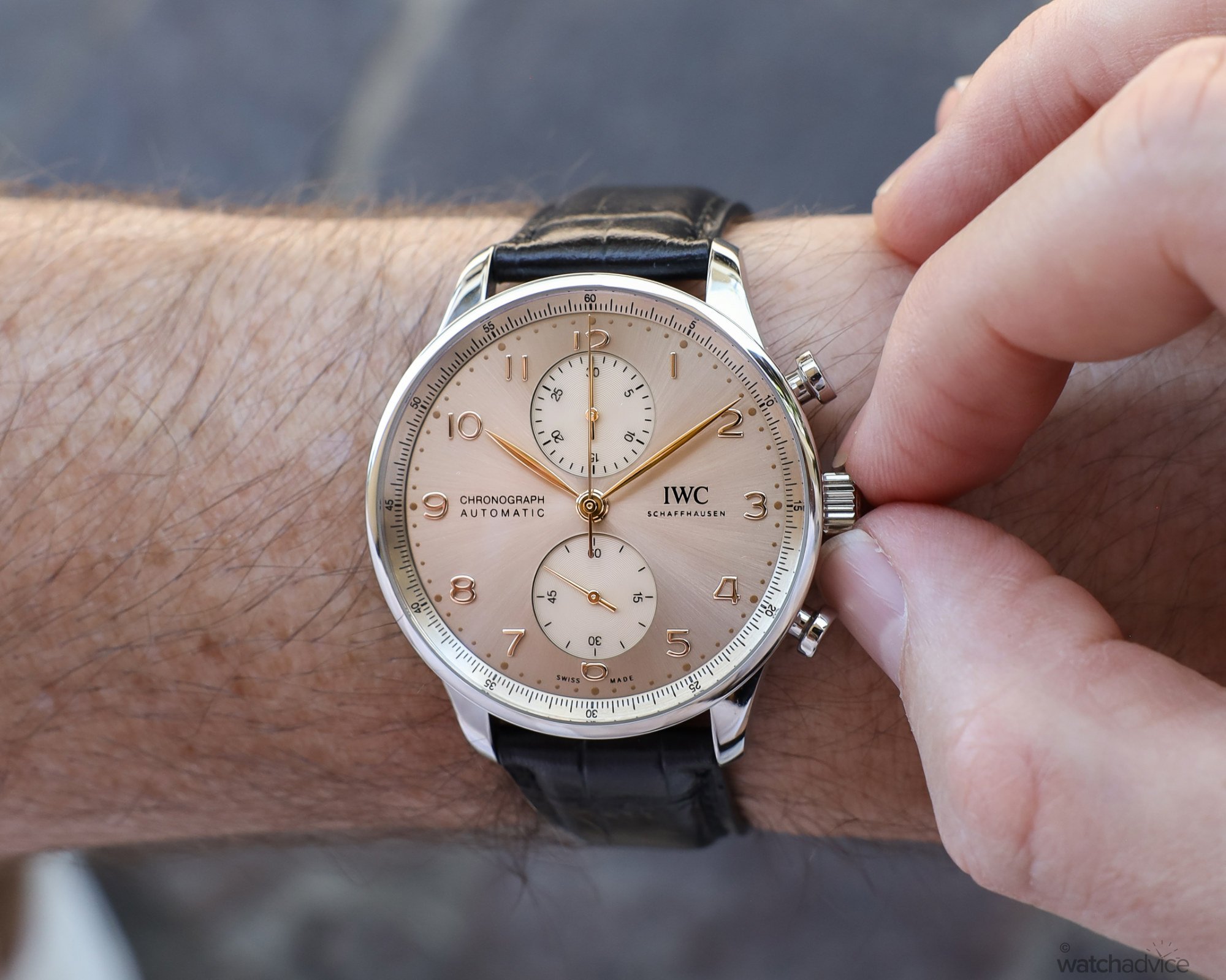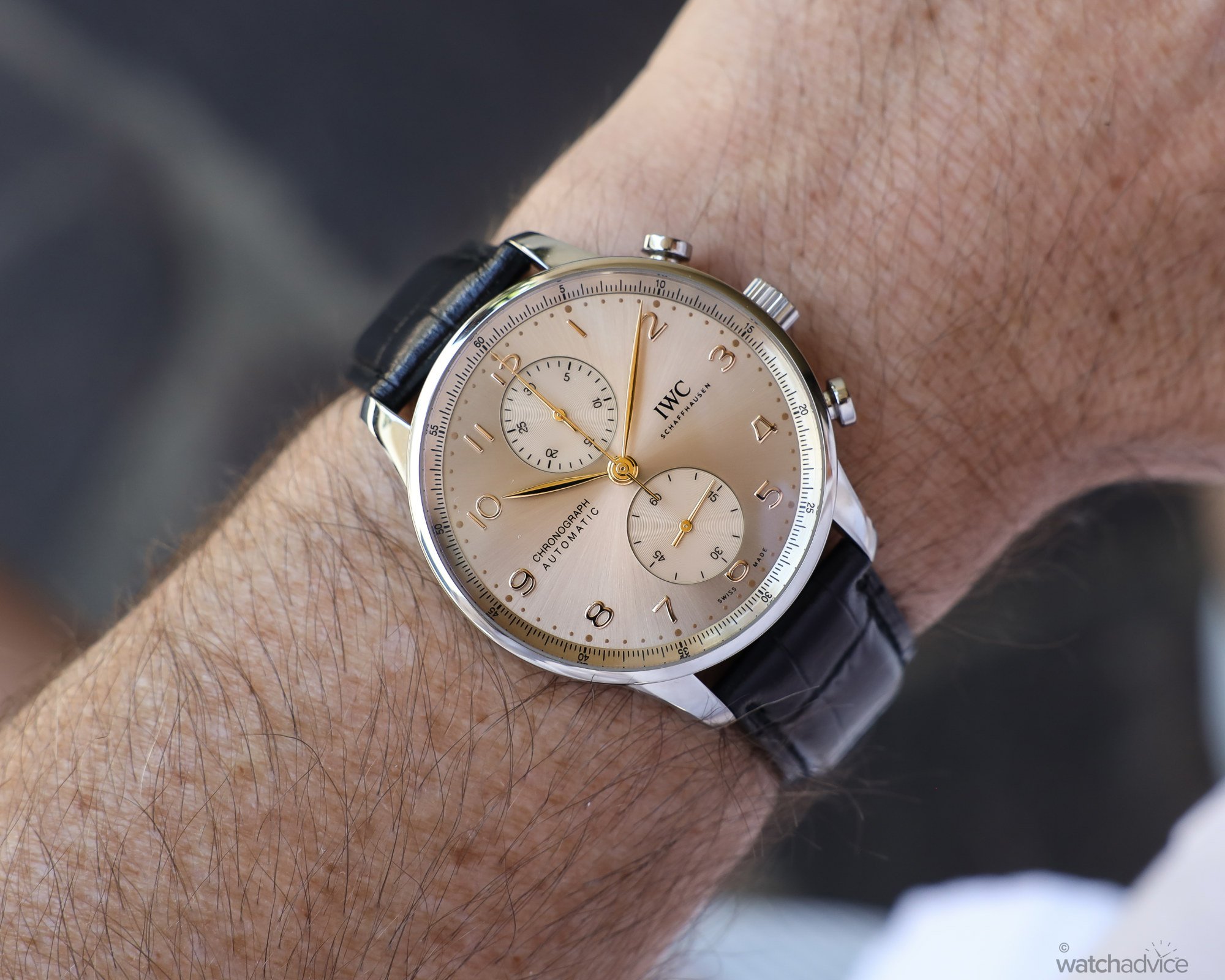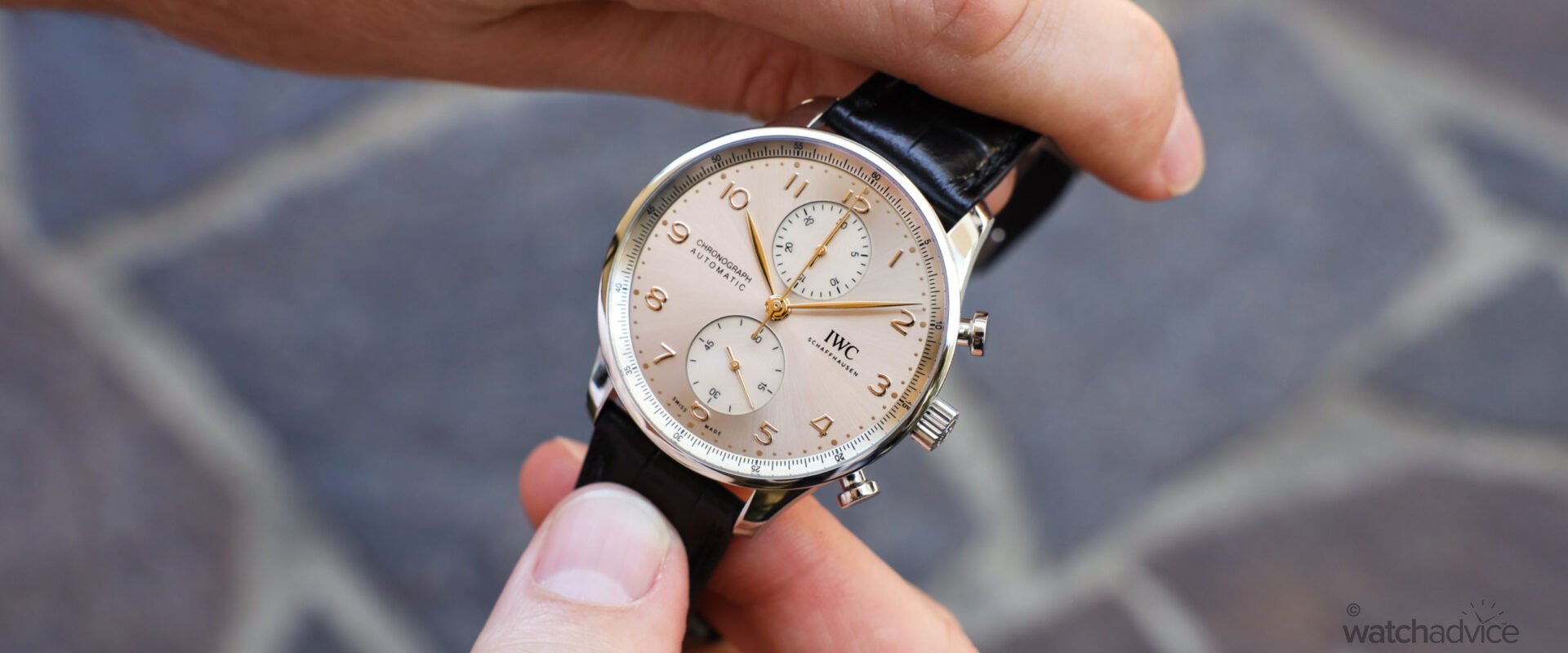The IWC Portugieser is one of the Schaffhausen brand’s most iconic models, and with a new lineup this year, we thought we would take the new Portugieser Chronograph ‘Dune’ out to see how it feels on the wrist.
What We Love
- The watch’s ability to pair with most outfits
- The dial finishing is excellent, with the sunray finish looking stunning
- The design is timeless and won’t date easily
What We Don’t
- The monochromatic coloured dial could use some contrast to aid with legibility
- The clasp is a little hard to open
- The lack of a date window gives it less functionality
Overall Score: 8.6 / 10
- Value for Money: 8/10
- Wearability: 9/10
- Design: 8.5/10
- Build Quality: 9/10
2024 has been a stellar year for IWC Schaffhausen. They launched the new look Portugieser collection at Watches & Wonders 2024, which I felt was one of the best collections released at the fair this year. Whilst other brands focused their efforts on just a few models or high complications, IWC took the opportunity to re-vamp the entire line, with new colourways reflecting the times of the day and in steel and precious metals. They also had an epic soundtrack playing in their booth, which could be heard throughout the Palexpo, so it was almost as if IWC provided the soundtrack to Watches & Wonders 2024.
They also released the Portugieser Eternal Calendar as part of this collection which was the brand’s contribution to the high-end pieces we saw throughout the fair, which then went on to break the Guinness World Record for most accurate moon phase in a wristwatch, and most recently taking out the Aiguille D’Or, the top prize at the GPHG awards last month.
So with all this playing out with the Portugieser collection, we’ve been lucky enough to get our hands on a couple of the new releases this year. Chamath was seen sporting the IWC Portugieser Perpetual Calendar in Horizon Blue (my personal favourite of the entire collection), last month for a bit, and I’ve now been able to wear the Portugieser Chronograph 41 in the ‘Dune’ colour for a week.
First impressions
Well, it is really my second, actually, third first impression with this piece, having had the chance to see it first at Watches & Wonders, then a few months ago at an event in Brisbane with IWC and The Hour Glass. But each time was a little fleeting, and with lots of other people, so this was the first time I had it in my hands and all to myself to get a proper “First Impression” of the watch.
The Dune colourway is unique in the fact there are not too many other watches on the market today that have a similar colour dial. I’m getting more and more into watches that are not your typical watch, and while that is a broad statement, when it comes to dials, something a little different to the standard black, white or dark blue is refreshing.
It is an elegant-looking watch as well, which is kind of the point of the Portugieser collection. It’s part contemporary and part historical, something that Christian Knoop, Chief Design Officer at IWC Schaffhausen talked to us about when we caught up with him earlier this year in Geneva.
“In the Portugieser you have to respect that it is more consistent and is going in a continuous and timeless direction. We look at the Portugieser as still a very contemporary watch, and not a kind of traditional watch…It’s not like people look at this and say, Oh, this is a traditional watch! No, it should be received as an incredibly modern watch!”
Christian Knoop, Chief Design Officer for IWC
That being said, I still see the Portugieser as being a little more formal in nature, and with the alligator leather strap, it is even more so than on the rubber, so I was keen to see how I would go with a more dressy watch compared to my usual pure sports pieces. The one area I’ll point out that is different in the ‘Dune’ Portugieser Chronograph is the monochromatic dial. While the other colour variants have contrasting numerals and hands, this is all done in the golden ‘Dune’ colour. More on that later…
The Design
The IWC Portugieser dates back to the late 1930s, and rather than the Art Deco design style, which was popular at the time, IWC went the more German Bauhaus route. This DNA can be seen in the Portugieser today, but with a whole suite of modern design cues, not to mention materials. These design cues are present across the entire range of the Portugieser collection, but in reference to this particular model, the 41mm Chronograph, we can see the modern and clean interpretation of the DNA shining through.
RELATED READING: Legacy Of Iconic Watch Designs – The IWC Schaffhausen Portugieser
The dials on the new collection are the focus points for the Portugieser, so much so that they have been designed with different times of the day in mind. With ‘Dune’, it reflects the way the light permeates everything in a golden glow in the late afternoon, that time just before dusk. You can see this coming out in the striations of the beautifully finished sunray dial, and to create this depth and effect, IWC applies 15 layers of transparent lacquer, part of the 60-step process that goes into designing just the dials themselves. Having the symetrical two-subdial design, there is no date window on the IWC Portugiser Chronograph. For me, I love to have a date as it adds to the functionality of the watch, I’m constantly using it. For others, it won’t matter much at all, so it depends on which side of the fence you sit on this issue as to whether this will bother you or not.

The ‘Dune’ Portugieser has hand-applied numerals on the dial, done in a rose gold plating and polished, allowing them to catch the light and reflect it at different angles. This also goes for the hands on the Portugieser Chronograph, finished beautifully with a slim curved profile. This elevates the watch and takes it out of the sports watch category and into a more dress watch category. The sub-dials have a beautiful graining to them, milled directly into the brass dial and then the way IWC prints on them allows for a greater 3D effect.

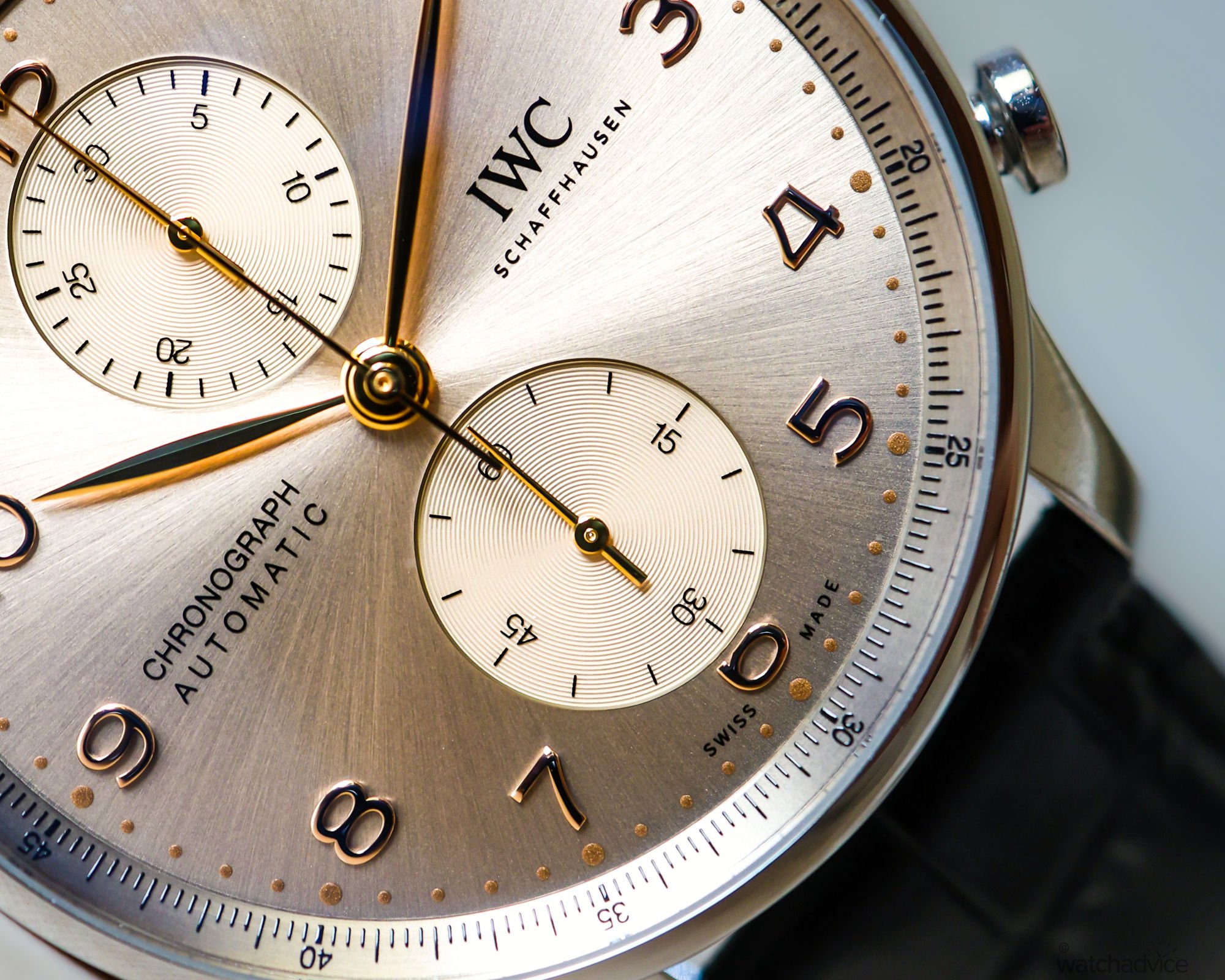
The one element I found with the dial, being all the same colour, is the lack of contrast. For me, the matching colours of the dial, subdials, hands and numerals were perhaps a little too much. Compare this to the ‘Horizon Blue’, the ‘Obsidian’ or the ‘Silver Moon’ dials which all have contrasting dial elements. ‘Horizon Blue’ has rhodium-plated hands and numerals that are silver to contrast with the light blue dial, the ‘Obsidian’s’ are gold on the black dial and on the ‘Silver Moon’, you have blue hands and numerals that pop against the silvery dial. This is more a personal preference, so depending on your likes or dislikes, may or may not be for you.
RELATED READING: IWC Launches New Portugieser Chronograph Collection
The case is pure Portugieser in the sense that is so recognisable when looking at it compared to the original reference 325. The curved lugs help the watch to get a better fit, and the shape has remained relatively unchanged for almost 100 years, albeit more refined, obviously. This is where the DNA of a watch comes in. Those design cues are iconic and lets a watch transcend time, allowing it to be both modern in style, and timeless in design. It’s a hard line to walk, but the best watchmakers do it well. The Portugieser is no exception and the combination of the brushed steel case, the flat pump style chronograph pushers and the polished raised bezel encompassing the dial let the Portugieser Chronograph fit in with our tastes in 2024, without losing the heritage of the past.

How It Wears
On my 17.5cm wrist, it looks pretty proportionate and the curved lugs make it wear pretty well. It doesn’t seem overly thick either, and at 13.1mm it is in the range of not being thin, but not too thick either. Also, thanks to the case design with only about half of the thickness being attributed to the actual case side itself, you don’t notice it as much. I feel it wears pretty true to the measurements on paper, potentially looking slightly bigger than 41 millimetres perhaps due to the lack of a flat bezel and a larger dial area, but only slightly. It’s really neither here nor there.
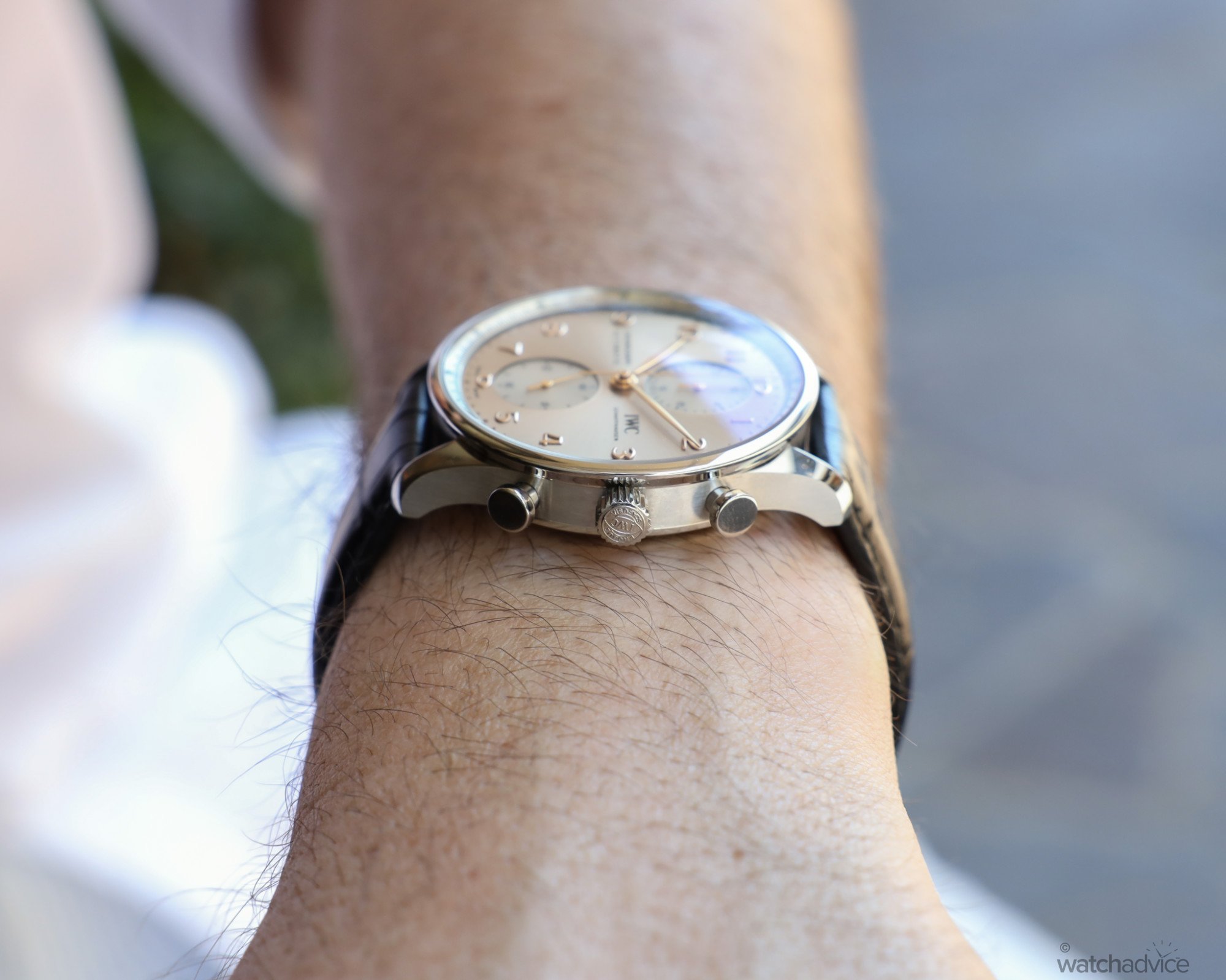
From the top down, you get another perspective here, and as a comparison, I’ve added in Champs’ wrist to show the 17.5cm circumference of my wrist compared to the 16.5cm of Champs’. While it potentially fits mine slightly better (I also don’t wear my watches as tight as Chamath does), the 41mm diameter and 48mm lug-to-lug on his wrist seems proportionate as well.
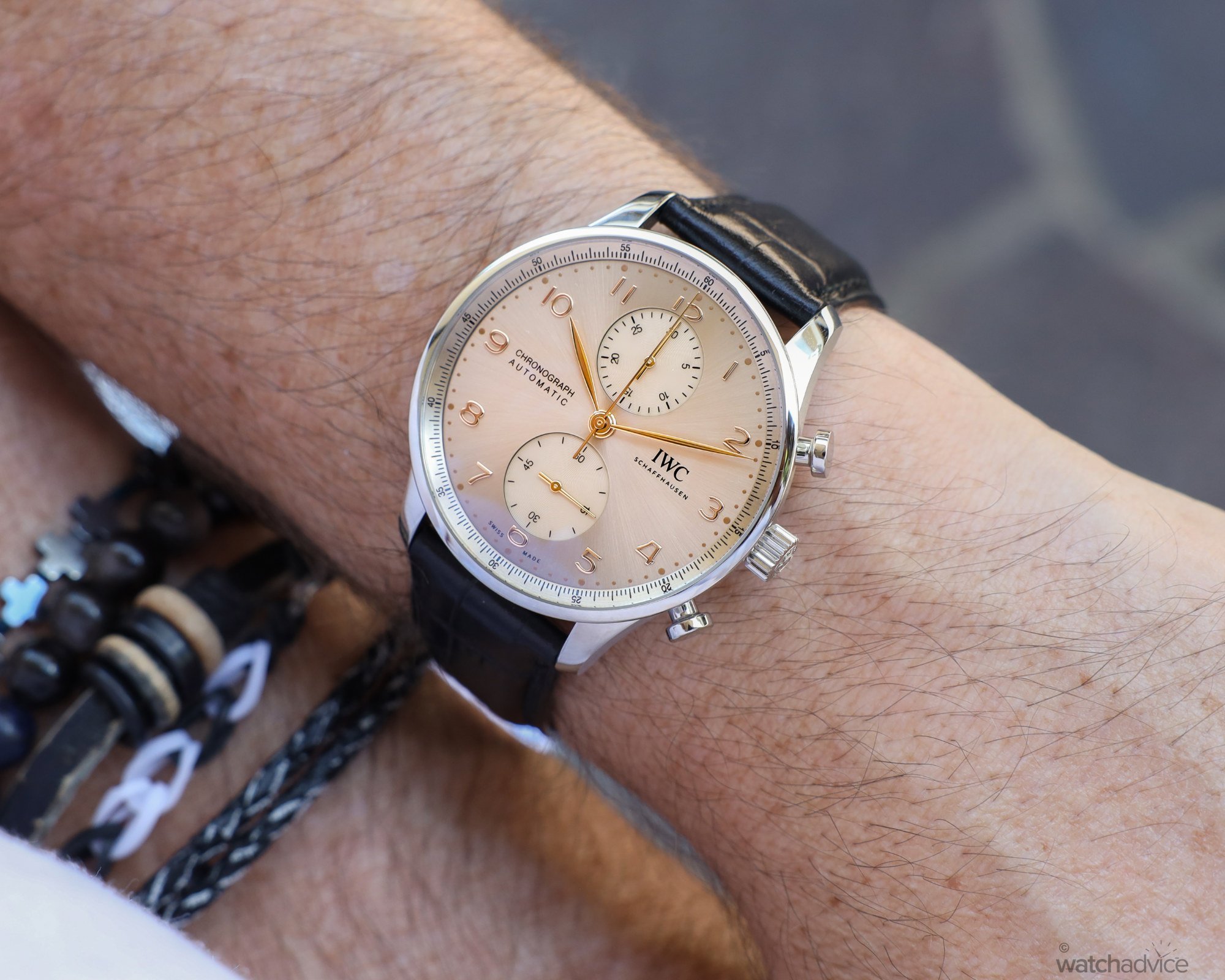
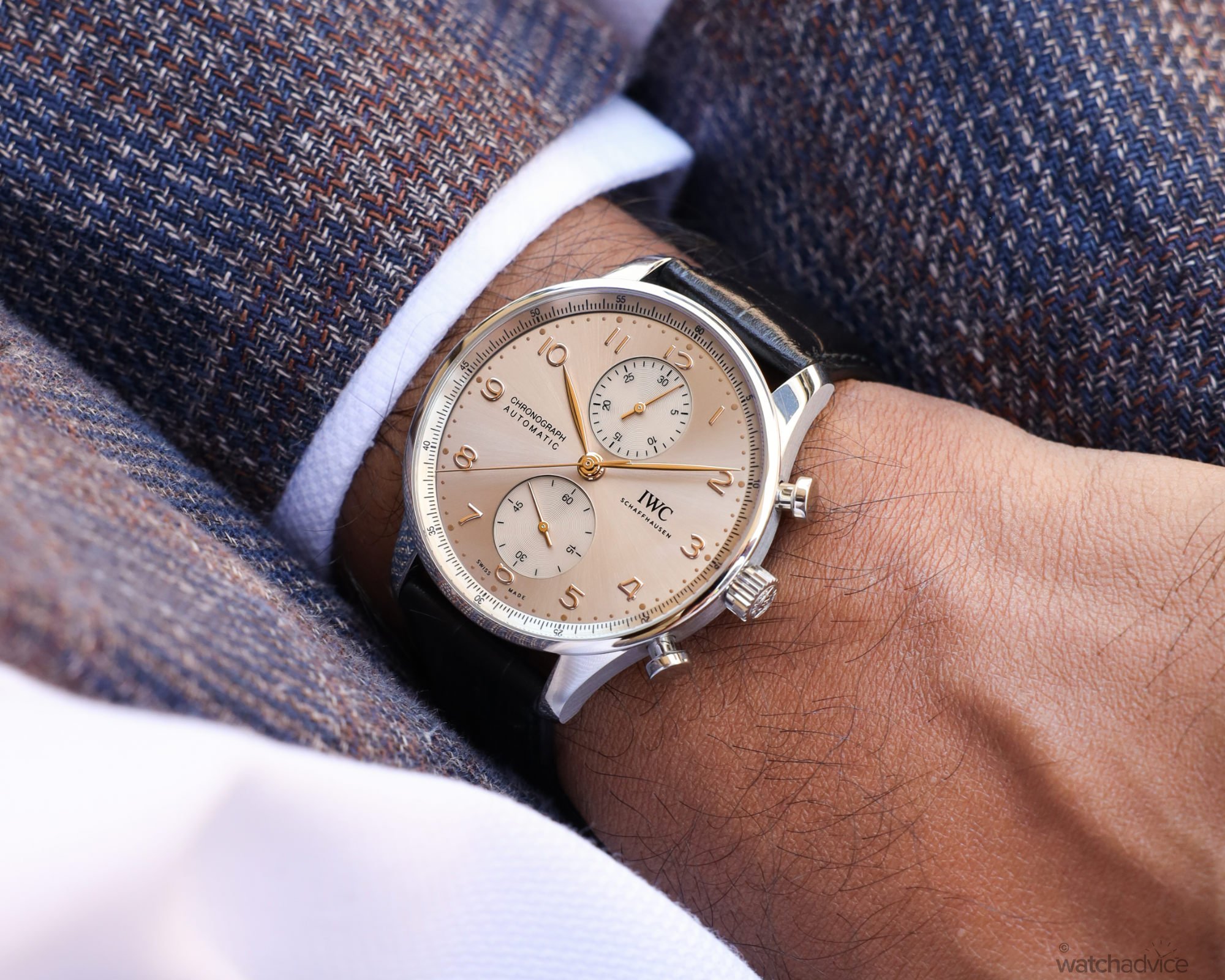
If you can get the right fit, it feels fairly comfortable to wear, but as it’s on a leather strap with a folding clasp and pin buckle, you will just need to play around with this and wait for the leather to soften and mould to your wrist after a little bit of wear. Being warm at the moment, I found that my wrist was in between the holes on the strap so a good fit wasn’t easy for me to achieve. As a result, I had to wear it on the slightly loose side, but in the warmer weather, this is most certainly not a bad thing!
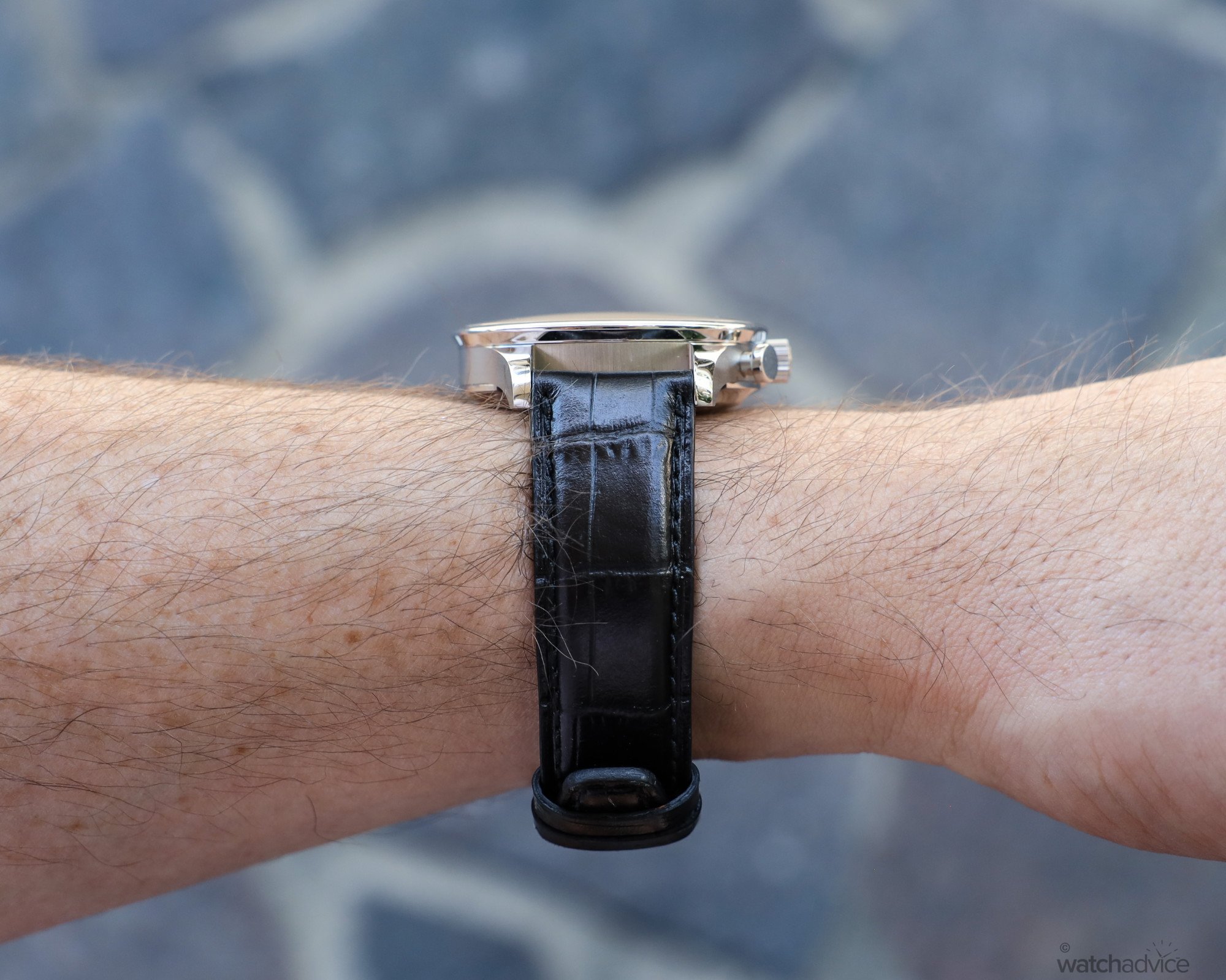
One thing I don’t love about the claps on the IWC is it is hard to undo once on the wrist as it’s a friction release clasp, not a push button. So taking it off does require you to grasp it firmly on either side and pull it, alternatively, slide your finger under the clasp as a lever to unclip it. With this style of clasp, which is not unique to IWC I’ll say, they are always a little tricky to open, so my preference would be to have a push button release to make it easier and with less wear and tear.
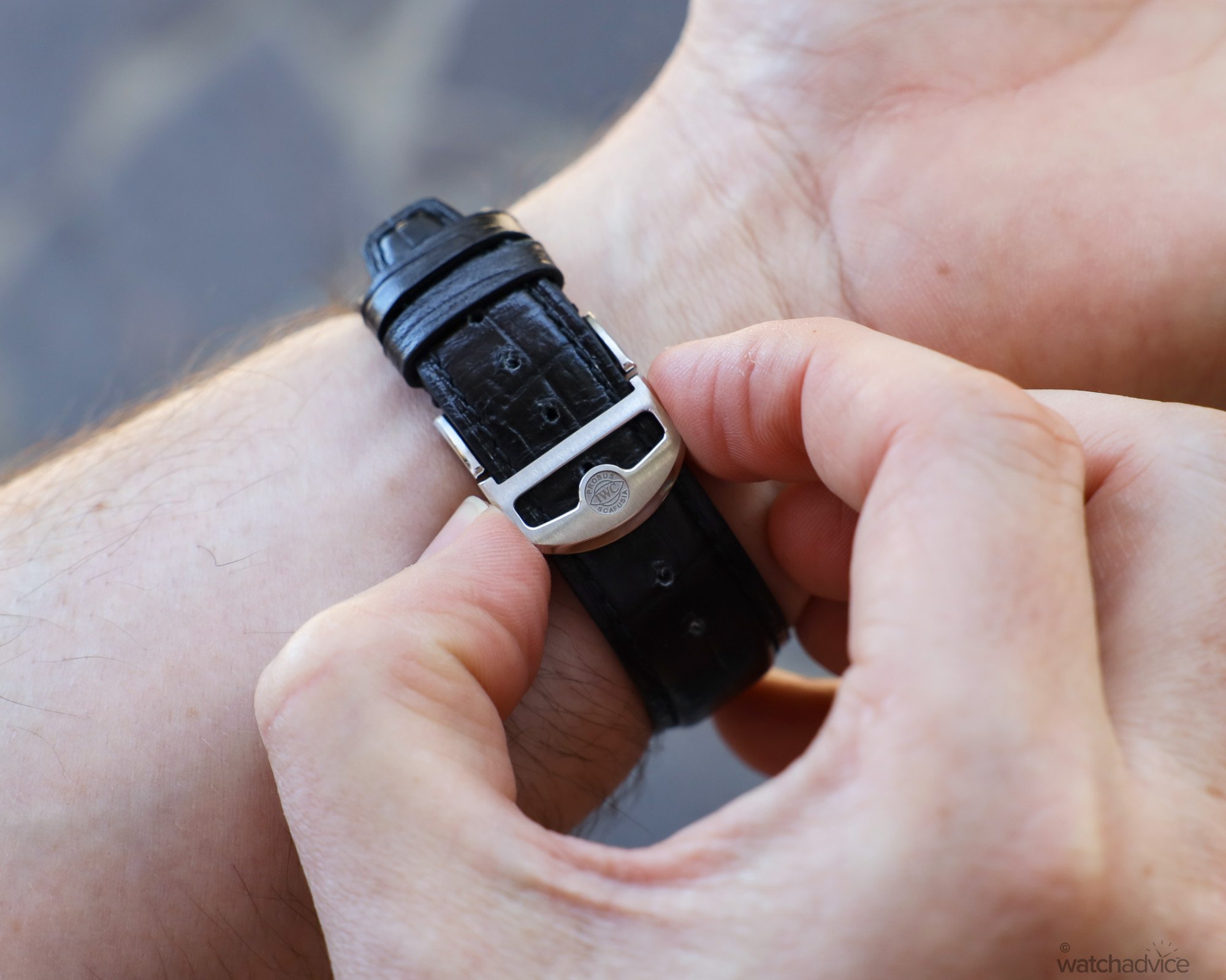
Now, coming back to the style factor here, being a more dressy watch, I wanted to see how this piece wore around town, and given it’s now summer and the hot weather is here to stay, how I felt with it on in more casual attire. I’m not talking about gym clothing or singlets and boardshorts, but more just your day-to-day wear when out in the city, doing school drop-offs, coffee at a café, that sort of thing. I feel it did play the more casual part, elevating what I was wearing to a point and given that the Portugieser isn’t a dress watch so to speak with more sporty elements to it, you don’t feel like you’re trying to pass it off as something it’s not. This probably exemplifies what Christian Knoop spoke about with the modernity of the piece – those subtle style and design cues allow it to be more than one thing.

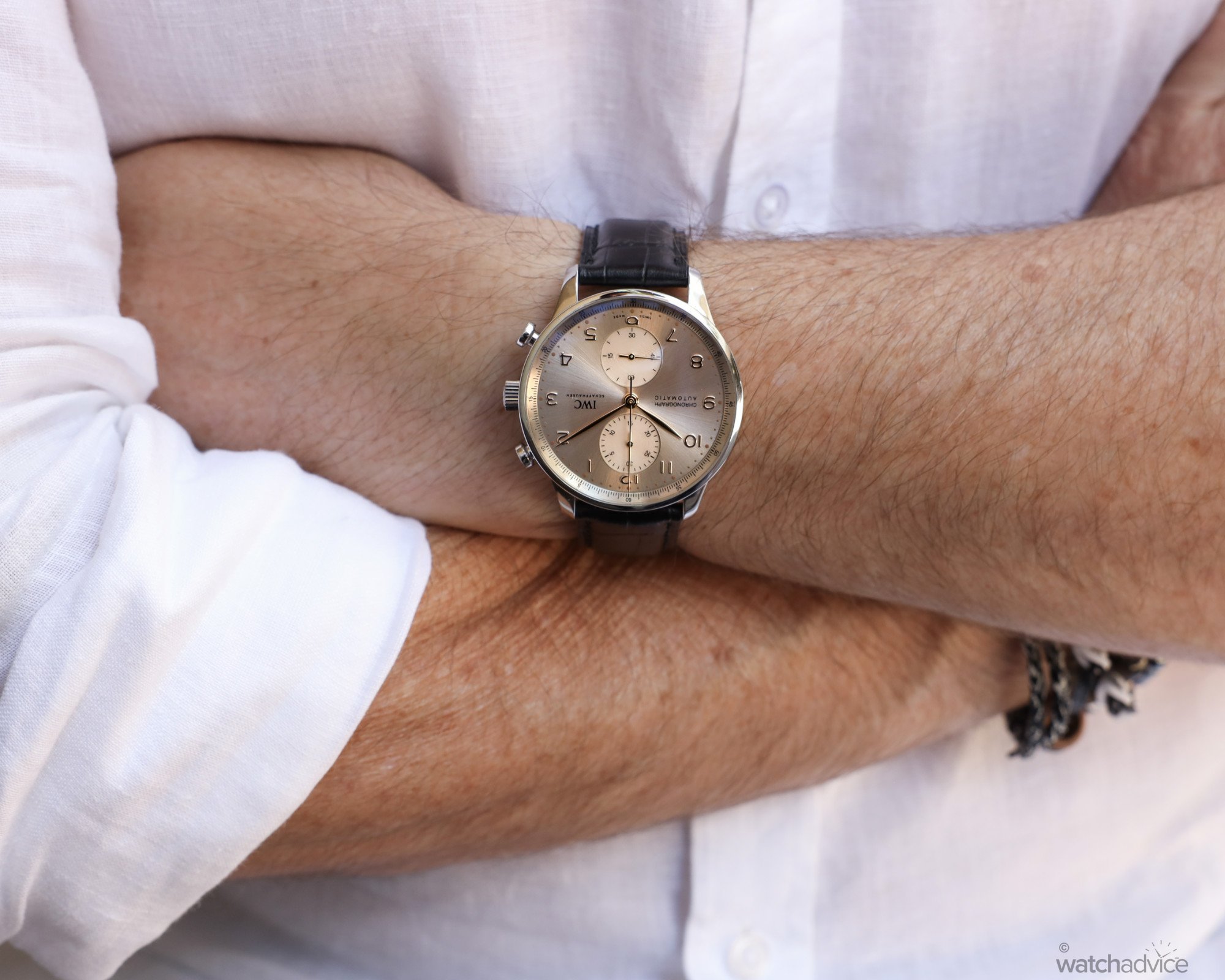
I mentioned in a previous review about the way many brands are now doing the reverse style strap, threading the strap though towards the body (if you’re wearing it on your left as most people do), which is the case on the Portugieser, rather than away from the body. I personally find this a little weird, only because I’m not used to it for the most part. I did mention however in the aforementioned review that the end of the strap would catch my pockets as I walked thanks to the longer strap and it protruding a little. It was something I hadn’t considered with the strap around this way, until it happened numerous times that is. Thankfully, the Portugieser didn’t have this issue at all as the strap is a little shorter at the end, and the double strap minders keep it in place.

The Movement
IWC are putting more and more emphasis on their movements these days. Back in 2018, they released the Calibre 69355 which was a full in-house manufactured movement brought out to help celebrate their 150 years. This is part of IWC’s 69000 family of calibres, which is the automatic winding chronograph utilising a column wheel and a bidirectional pawl-winding system. For the calibre 69355, IWC has altered this to drop the chronograph hour sub-dial function, basically due to aesthetic reasons to balance out the dial itself. The movement pivots on 27 jewels, is adjusted to five positions and beats at a 4Hz beat rate with a standard 46-hour power reserve. Yes, the power reserve could be better and bumped up to 72 hours, which is becoming more and more the standard these days, but as this is a piece meant for everyday wear, then it’s less of an issue.

Operating the chronograph, the buttons are crisp, with the start/stop pusher having a small amount of resistance when starting the timer. The reset button is a little bit softer to the touch, with a bit less resistance, but I feel this is a good thing as it makes the chronograph easier to use when resetting it quickly. While I may be a little critical of the way the pushers feel, that is the watch reviewer coming out in me. For the average person however, this won’t matter all that much, or even be noticeable, whereas for me, I’m comparing this to all other chronographs I’ve tried and tested over the years.
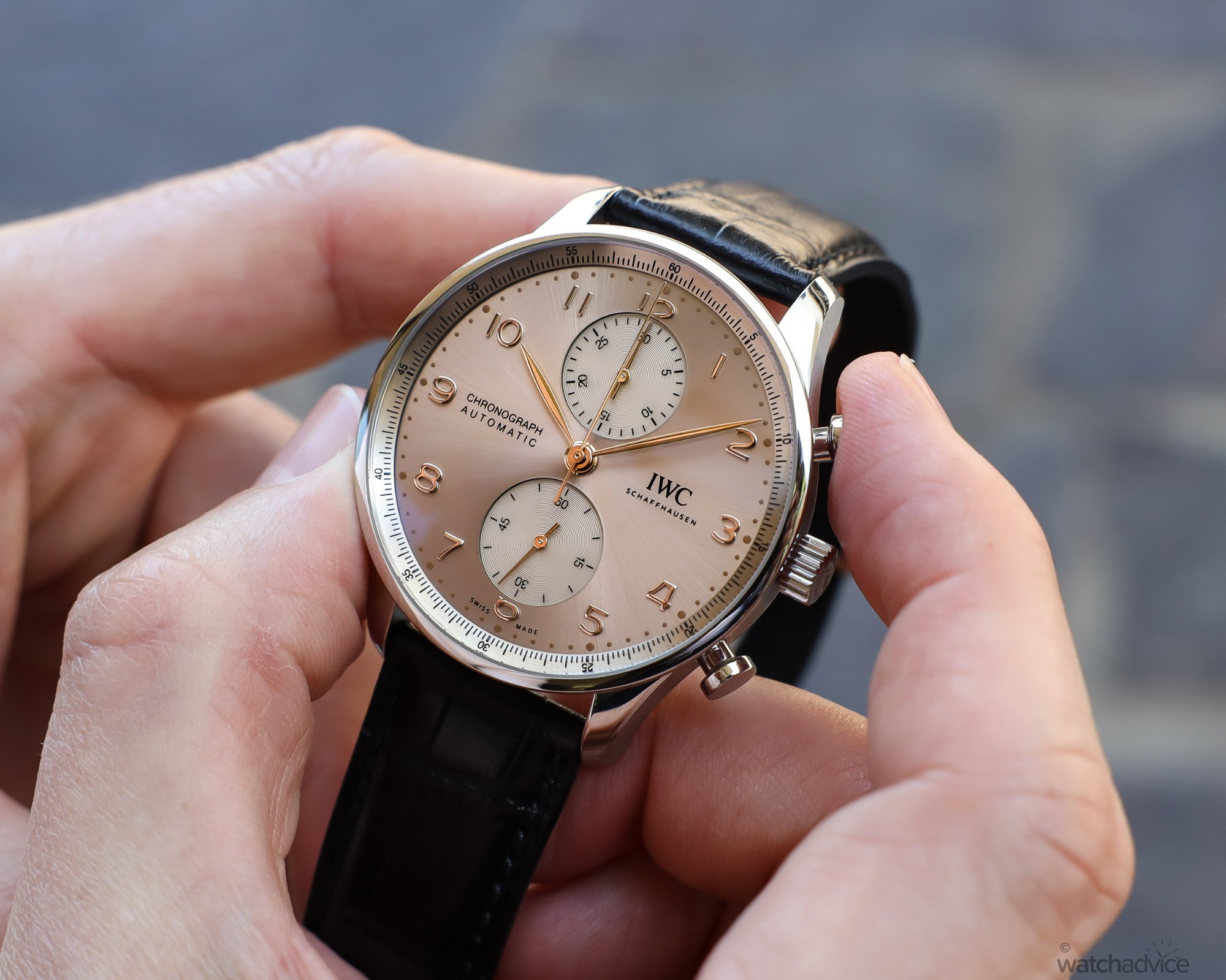
The pull-out crown is easy to operate when changing the time. The knurling is enough to offer grip and there is very little movement or give in the crown when setting the time, meaning you’re not turning the crown much before the hands start to move. You sometimes have this on less well-made watches, turning the crown sometimes up to 30 degrees before the hands turn, making it harder to set the time accurately. It’s a big bugbear of mine, and if this happens, it shows that the crown stem isn’t tight allowing movement in it before the ratchet wheel starts to come into play against the gear train.
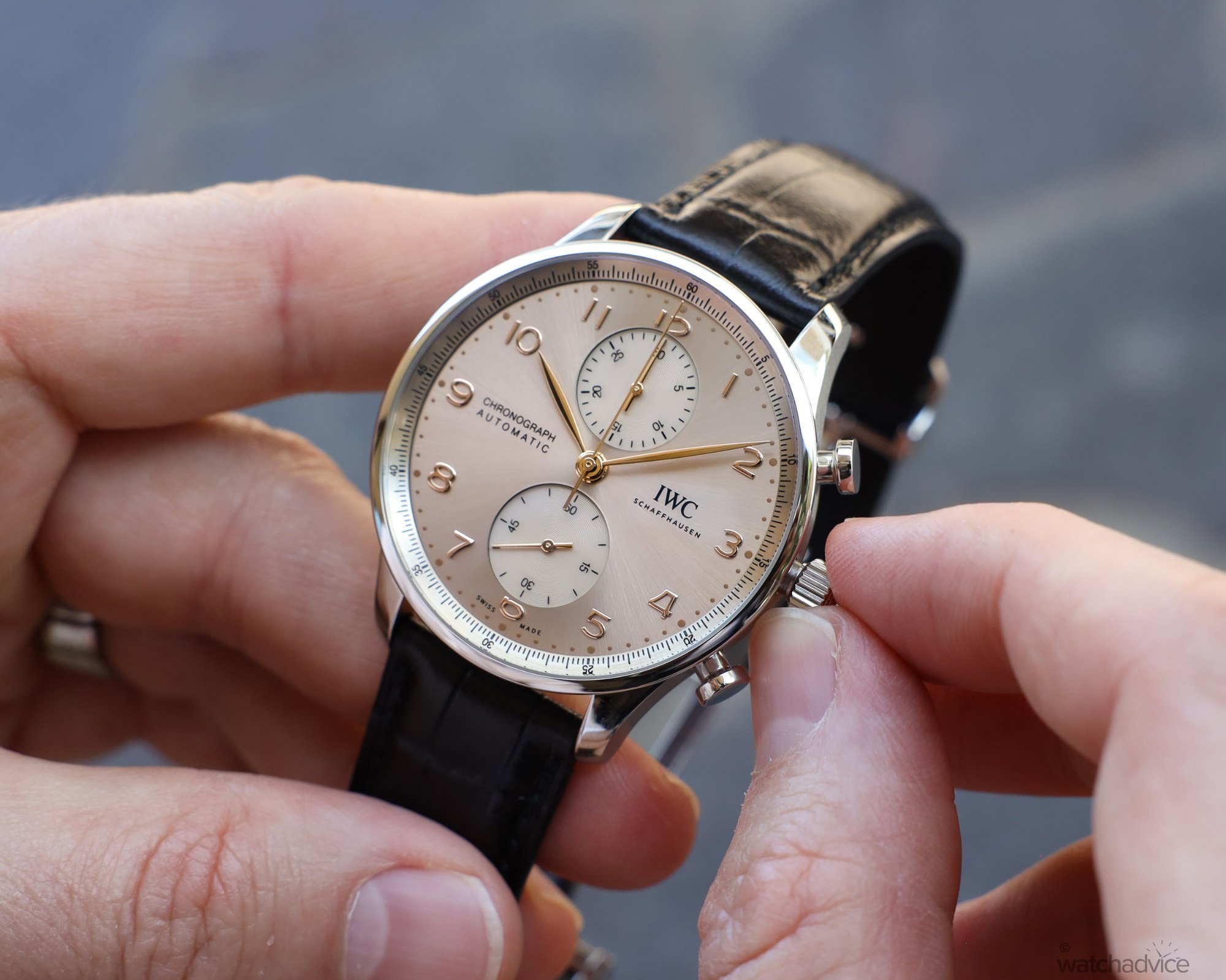
The winding mechanism also has a great tactile feel in this watch when winding it manually. I would say it is a smooth crispness, not gritty or clunky like some. Again, this is a watch nerd thing, but is one way of seeing, feeling and hearing how well the movement is put together. The crisper and smoother the feel, the better (in most instances) the movement is made.
Final Thoughts
IWC at its core is a brand that has an engineering heart, designing watches with movements that are engineered very well, both in design language and construction. You see this with not only the Portugieser collection but most of their watches across the different model lines. The Portugieser, for me anyway, has always been a collection that is about simplicity and elegance, but with that slightly sportier edge, and because of this, I have slightly mixed feelings about the IWC Portugieser Chronograph ‘Dune’.
On one hand, it’s a great watch, with a timeless design, from a brand that I have a lot of respect for and is elegant with a touch of sportiness about it, as I’ve just mentioned. On the other hand, I’m not sure if the ‘Dune’ colourway was for me personally, and without a date function, and on a leather strap, it’s less of a day-to-day piece for my lifestyle – so I’m slightly conflicted. That being said, this variant is the only steel model of the new chronograph models released this year, with Horizon Blue and Obsidian in white and red gold respectively, so it’s more durable for everyday wear but elegant enough for dressing up for more formal occasions.
My feeling is that for someone like me, who gravitates a lot more towards sports steel pieces, it takes a little while to warm up to. But that’s ok as sometimes watches grow on you the more you wear them, and the Portugieser Chronograph in ‘Dune’ did just that. It grew on me over the week, and because of this, I found myself picking outfits that would better compliment the watch, and I did feel a little dapper with it strapped to my wrist.
Overall I enjoyed wearing it – it gave me something different to wear on a daily basis that pushed me out of my comfort zone so to speak, in a colour that is different to what I would have traditionally chosen. In this statement, there is a lesson for me, and for those readers out there stuck in a certain way when it comes to watches. That is, try on different pieces and get out of your comfort zone. Try something you wouldn’t normally wear and see how it makes you feel, and when it comes to your next purchase, you may just find yourself picking out a watch that adds more variety to your collection!
References: IW371624 ‘Dune’
Specifications:
- Dimensions: 41mm, 13.1mm thick & 48mm lug-to-lug
- Case Material: Brushed and polished Stainless Steel
- Dial: Sunray brushed ‘Dune’ colour with applied numerals, milled subdials and red-gold plated hands
- Crystal: Sapphire, convex, antireflective coating on both sides
- Water resistance: 30m / 3 Bar
- Movement: IWC-manufactured calibre 69355 beating at 4Hz (28, 800 VpH) and 27 jewels
- Power reserve: 46 hrs
- Strap: Black alligator with steel folding clasp with pin buckle
Australian Recommended Retail Price: A$13,200
Availability: Available now at IWC Boutiques, authorised retailers or online at IWC.com
Full Image Gallery
